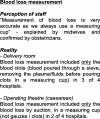Bottom-up development of national obstetric guidelines in middle-income country Suriname
- PMID: 31500615
- PMCID: PMC6734520
- DOI: 10.1186/s12913-019-4377-6
Bottom-up development of national obstetric guidelines in middle-income country Suriname
Abstract
Background: Obstetric guidelines are useful to improve the quality of care. Availability of international guidelines has rapidly increased, however the contextualization to enhance feasibility of implementation in health facilities in low and middle-income settings has only been described in literature in a few instances. This study describes the approach and lessons learned from the 'bottom-up' development process of context-tailored national obstetric guidelines in middle-income country Suriname.
Methods: Local obstetric health care providers initiated the guideline development process in Suriname in August 2016 for two common obstetric conditions: hypertensive disorders of pregnancy (HDP) and post partum haemorrhage (PPH).
Results: The process consisted of six steps: (1) determination of how and why women died, (2) interviews and observations of local clinical practice, (3) review of international guidelines, (4) development of a primary set of guidelines, (5) initiation of a national discussion on the guidelines content and (6) establishment of the final guidelines based on consensus. Maternal enquiry of HDP- and PPH-related maternal deaths revealed substandard care in 90 and 95% of cases, respectively. An assessment of the management through interviews and labour observations identified gaps in quality of the provided care and large discrepancies in the management of HDP and PPH between the hospitals. International recommendations were considered unfeasible and were inconsistent when compared to each other. Local health care providers and stakeholders convened to create national context-tailored guidelines based on adapted international recommendations. The guidelines were developed within four months and locally implemented.
Conclusion: Development of national context-tailored guidelines is achievable in a middle-income country when using a 'bottom-up' approach that involves all obstetric health care providers and stakeholders in the earliest phase. We hope the descriptive process of guideline development is helpful for other countries in need of nationwide guidelines.
Keywords: Clinical guidelines; Contextually-tailored guidelines; Hypertensive disorders of pregnancy; Locally adapted guidelines; Middle-income country; Post partum hemorrhage; Suriname.
Conflict of interest statement
The authors declare that they have no competing interests.
Figures
References
-
- Stokes T, Shaw EJ, Camosso-Stefinovic J, Imamura M, Kanguru L, Hussein J. Barriers and enablers to guideline implementation strategies to improve obstetric care practice in low- and middle-income countries: a systematic review of qualitative evidence. Implement Sci. 2016;11(1):144. doi: 10.1186/s13012-016-0508-1. - DOI - PMC - PubMed
MeSH terms
LinkOut - more resources
Full Text Sources
Medical
Molecular Biology Databases



